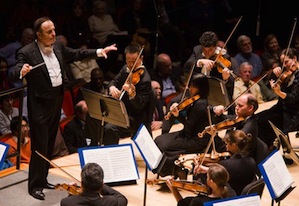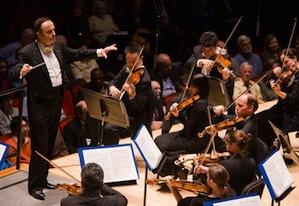
San Francisco symphonic music lovers have a deep affection for the Philadelphia Orchestra, and the feeling must be mutual. The Philadelphians were in town last weekend to conclude the San Francisco Symphony’s American Orchestra Series, and Conductor Charles Dutoit had assembled two programs of crowd-pleasers — but not your every-day ones.
With all compositions (except one) written between 1894 and 1943, the concerts were an interesting illustration of European classical music during the politically tumultuous first half of the 20th century, when a new musical consciousness was struggling with the limits of the ‘old-fashioned’ tonal system and the New World was on the rise as a cultural influence.
Individually however, these pieces mostly served to highlight the beautiful, lush sound of the Philadelphia Orchestra. Chronologically, the musical path went from Debussy’s Prelude to The Afternoon of a Faun (1894) to Scriabin’s Poem of Ecstasy (1907), Ravel’s Piano Concerto in G Major (1932), Shostakovich’s Symphony No. 5 (1937), the Symphonic Dances Op. 45 by Rachmaninov (1941), and Hindemith’s Symphonic Metamorphosis on Themes of Carl Maria von Weber (1943).
The only new piece on the program was Saratoga (2005), commissioned by the Philadelphia Orchestra and written by Iranian-born composer Behzad Ranjbaran (b. 1955), which opened Sunday’s concert. Harmonically speaking, Saratoga is unmistakably modern, but the distance between Ravel’s and Rachmaninov’s vernacular and Ranjbaran’s musical language is not that big. The composer, who was at Sunday evening’s concert, works through his thematic material and musical structure with traditional craftsmanship. He creates a solid, very well orchestrated piece with lots of substance and character that is very enjoyable for the listener and visibly fun to play for the orchestra. Musician’s music.
Rachmaninov’s Symphonic Dances, also written specially for the Philadelphia Orchestra, was a chance for Dutoit and his musicians to shine. Swiss-born Dutoit (1936) is not a particularly exuberant conductor. His movements are measured, effective and to the point — and never particularly dramatic. But he meets the needs of the music and his musicians like few others, and manages to build and maintain musical tension even when the entire orchestra is down to a whisper.
Dutoit’s hands became more expressive when he put down his baton and conducted Prelude to The Afternoon of a Faun. Debussy’s score was an evocative prelude to Scriabin’s less familiar Poem of Ecstasy because a transition between the two pieces could almost go unnoticed. But where Debussy stays subtle and controlled throughout, Scriabin quickly loses himself in large, bombastic and almost pompous gestures. Dutoit doesn’t surrender to Scriabin’s grandiosity, but he is also not afraid to pull all the stops. After an evening of already very dense music it was a bit much, and the orchestra must have been exhausted after such a tour de force; I felt sorry for the trumpets. The encore, Sibelius’ Valse Triste, was a welcome soothing balm before Dutoit shooed everyone out of the concert hall.
The Saturday concert had a lighter touch and less musical density, but also more volatility. Paul Hindemith’s reworking of themes by German romantic composer Carl Maria von Weber (1786-1826), arguably his most popular work, was a brilliant opening, and frankly the highlight of the two concerts. In Hindemith’s treatment, Weber has almost completely disappeared, but the piece works on many different levels: It is whimsical and ironic and it seems to thumb its nose to some kind of establishment, especially in the Scherzo. It also gives ample opportunity to showcase the qualities of the entire orchestra, including soloists. This was the Philadelphia Orchestra in a nutshell.
French-Canadian pianist Louis Lortie joined Dutoit and his orchestra for Ravel’s Piano Concerto in G Major. Lortie’s playing is technically perfect, brilliant and effortless and he obviously knows the piece inside out. In the outer movements of this Concerto, we find Ravel excitedly applying rhythms and harmonies from jazz, the ‘new’ music style from America. The languid middle Adagio however, seemed to induce a sort of schizophrenic disjointedness between the orchestra and the piano. As if Lortie and Dutoit were ‘parallel playing’; each in their own little universe, but somehow not together. The chemistry between orchestra and pianist faded briefly and the Adagio came out too schmaltzy for my taste.
Also not entirely satisfying was Dutoit’s reading of Shostakovich’s Fifth Symphony, which concluded the Saturday concert. On the surface, this Fifth is a conventional four-movement piece of music for normal-size orchestra, written by Shostakovich to re-gain favor with the Soviet cultural authorities. The composer had been publicly denounced for his opera Lady Macbeth of Mtsensk (1934) in a Pravda editorial that was rumored to originate from Stalin himself. With this Fifth, Shostakovich was toeing the party line again, but it is widely believed that he was only window-dressing.
Dutoit seemed to have removed Shostakovich’s Fifth from its political undercurrent, focusing on the music alone. That is in itself a valid approach, and Shostakovich’s music is more than powerful enough to convince without added subtext. But I was longing for more grit, more subversive passion than romantic passion. The Philadelphia sound is exceptionally well suited for beauty, but Shostakovich also requires a certain degree of ugliness: screeching piccolo’s, bellowing horns and screaming violins. And that was certainly missing; it was too pretty.

